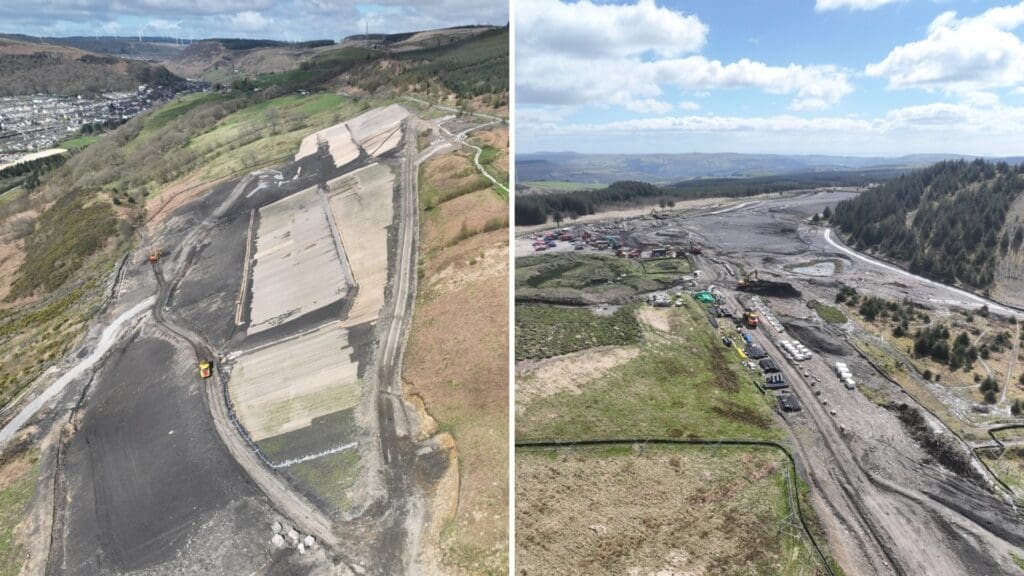RCT Council has provided an update on the Tylorstown Landslip remediation scheme, with Phase Four work ongoing. Current activity includes earthworks, transporting the remaining tip material to a receptor site, building infrastructure at receptor areas, and work within an extended drainage programme.
The landslip on the Llanwonno hillside in February 2020 was triggered by the unprecedented rainfall in Storm Dennis. It blocked the river valley, broke a foul sewer, covered a water main with several metres of debris, and covered a shared footpath. A four-phase remediation plan has been implemented – and included emergency clearance work in the weeks that followed (Phase One).
Phases Two (embankment scour repairs) and Three (removal of material from the valley floor to receptor sites and reinstatement of paths) are complete, along with additional work to stabilise the slope. Work as part of Phase Four (remediation of the remaining tip on the hillside) got underway during 2023.
Phase Four is removing around 195,000m3 of remaining material within the Llanwonno Upper Tip, as well as undertaking major landscaping and drainage works. The area will be re-profiled with 35,000m3 of material used to ‘smooth out’ the landscape. The process will transport around 160,000m3 of material along the disused tramway to the receptor site, located north of ‘Old Smokey’.
Latest progress update – spring 2024
Prichard’s Contracting has used the recent dry weather this spring to restart major earthworks in the existing tip – including removal of the small quantity of remaining tip material to a receptor site. Meanwhile, good progress has been made with installing infrastructure within the wider receptor area, with all major components constructed. Further activity such as topsoiling is now underway.
Additional positive progress has been made at Receptor Site A2, on land to the south of Station Road. Planning permission was granted in September 2023 to permanently retain around 740m3 of material from the landslip, and carry out landscaping and ecological mitigation measures on this area of land. Planting work has recently been completed as the final element of this work.
Significant drainage work has been ongoing since Phase Four got underway. In the Council’s previous update, it was noted that more than 1,500-metres of drainage piping had been installed – while the seasonal wet weather provided an opportunity to observe the changes to water movement and springs.
Due to new factors discovered by the contractor as the work has progressed, including water ingress and changes with the underlying topography, it has been necessary to extend the planned drainage programme to include extra mitigating measures. Now delivering a more substantial drainage programme, the overall completion of Phase Four has been extended to winter 2024.
A spokesperson for Rhondda Cynon Taf Council said: “The significant operation to remediate the Tylorstown Landslip has continued while battling the elements through the winter months – and with spring now bringing much better weather, focus will return to the major earthworks and removing the small quantity of remaining tip material to a receptor site. Once complete, it will represent a major landmark in Phase Four. Excellent progress has also been made with constructing and installing the receptor area infrastructure.
“Expanding the original drainage programme has been necessary in response to water ingress and topography changes – and this has extended the overall delivery timescale of Phase Four. The Council will keep the community up-to-date at key milestones in the months ahead, as our contractor looks to take advantage of the improved weather in spring and summer to make progress.
“Other key activity continues away from the site, including establishing a Land Management Group to take forward a five-year plan for the area, and work with South Wales Police to prevent off-road vehicles from illegally accessing such sites. The Council also remains committed to utilising the site as part of the Rhondda Fach Active Travel Route in the future, which will establish a surfaced path through the area and include repairs to several nearby bridges.”

